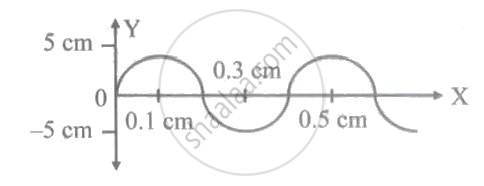Advertisements
Advertisements
Question
Define progressive wave.
Solution
Waves in which a disturbance created at one place travels to distant points and keeps travelling unless stopped by an external force are known as travelling or progressive waves.
APPEARS IN
RELATED QUESTIONS
Answer briefly.
Define amplitude.
Answer briefly.
Define wavelength of a wave.
Answer briefly.
Draw a wave and indicate points which are
- in phase
- out of phase
- have a phase difference of `pi/2`
State any four properties of progressive wave.
Solve the following problem.
A certain sound wave in air has a speed 340 m/s and wavelength 1.7 m for this wave, calculate
- the frequency
- the period
Two sinusoidal plane waves of the same frequency having intensities I0 and 4I0 are travelling in the same direction. The resultant intensity at a point at which waves meet with a phase difference of zero radians is ______
Two waves of the same amplitude superimpose to produce two beats per second. What is the ratio of minimum loudness to that of one of the waves?
The ratio of minimum to maximum wavelength in Balmer series is ____________.
Sound waves are passing through two routes one in straight path and the other along a semicircular path of radius r and are again combined into one pipe and superposed as shown in the figure. If the velocity of sound waves in the pipe is v, then frequencies of resultant waves of maximum amplitude will be integral multiples of ______.

In frequency modulated wave ______.
The frequency of a tuning fork is 384 per second and velocity of sound in air is 352 m/s. How far the sound has traversed while fork completes 48 vibration?
The wave of the wavelength 30 cm and frequency 100 Hz will be ______.
The following figure shows the shape of part of a long string in which transverse waves are produced by attaching one end of the slring to tuning fork of frequency 300 Hz. The velocity of the waves is ____________.

If velocity of sound in a gas is 360 m/s and the distance between a compression and the nearest rarefaction is 2 m, then the frequency of sound is ____________.
The frequency of a tuning fork is 220 Hz and the velocity of sound in air is 330 m/s. When the tuning fork completes 80 vibrations, the distance travelled by the ______.
A progressive wave of frequency 50 Hz is travelling with velocity 350 m/s through a medium. The change in phase at a given time interval of 0.01 s is ______.
When the observer moves towards a stationary source with velocity V1, the apparent frequency of emitted note is F1. When observer moves away from the source with velocity V1, the apparent frequency is F2. If V is the velocity of sound in air and `"F"_1/"F"_2=2` then `"V"/"V"_1` is equal to ______.
The displacement-time graphs of two particles A and B are straight lines making angles of 30° and 60° respectively with the time axis. If the velocity of A is vA and that of B is vB, the value of vA/vB is ______.
A source of 300 Hz frequency, an observer and a wind are moving as shown in the figure with respect to the ground. The frequency heard by observation is ______.

(Take, the speed of sound in air = 340 m/s)
Two instruments having stretched strings are being played in unison. When the tension of one of the instruments is increased by 1%, 3 beats are produced in 2 s. The initial frequency of vibration of each wire is ______.
An astronaut is approaching the moon. He sends out a radio signal of frequency 5000 MHz and the frequency of echo is different from that of the original frequency by 100 kHz. His velocity of approach wrt, to the moon, is ______.
A progressive wave of frequency 500 Hz is travelling with a velocity of 360 m/s. How far apart are two points 60° out of phase?
If a string fixed at both ends vibrates in four loops. The wavelength is 10 cm. The length of string is ______.
